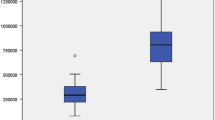Abstract
Aim
The purpose of this study was to evaluate the amount of total and types I and III collagens of samples from the linea alba in patients with hernias (epigastric, umbilical, and incisional) on the anterior wall of the abdomen, comparing them to findings obtained from a cadaver control group without hernias.
Materials and methods
Samples of the linea alba aponeurosis from 26 patients with hernias on the anterior abdominal wall and from 32 cadavers without hernias were analyzed and compared for qualitative and quantitative evaluation of the total and the types I and III collagens. Sirius-red staining was used to evaluate the total collagen, and for types I and III collagens, immunohistochemistry was used with monoclonal antibody anticollagen types I and III, respectively.
Results
The amount of total collagen was 18.05% smaller in patients with hernias than in cadavers (p<0.05). Type I collagen was 20.50% smaller in patients than in cadavers (p<0.05). There was no significant difference in the amount of type III collagen between cases and controls (p=0.383).
Conclusion
The results of this study indicate a relationship between hernias of the anterior abdominal wall and smaller amounts of total and type I collagens.





Similar content being viewed by others
References
DesCoteaux JG, Temple WJ, Huchcroft SA, Frank CB, Shrive NG (1993) Linea alba closure: determination of ideal distance between sutures. J Invest Surg 6(2):201–209
Rath AM, Attali P, Dumas JL, Goldlust D, Zhang J, Chevrel JP (1996) The abdominal linea alba: an anatomo-radiologic and biomechanical study. Surg Radiol Anat 18(4):281–288
Wolwacz JI, Trindade MRM, Cerski CT (2003) The collagen in transversalis fascia of inguinal hernia patients treated by videolaparoscopy. Acta Cir Bras 18(3):196–202
Micheau P, Grolleau JL (1999) Eventrations abdominale. Prise en charge et stratégie dans l’approche du futur opéré. Ann Chir Plast Esthet 44(4):325–338
Lang B, Lau H, Lee F (2002) Epigastric hernia and its etiology. Hernia 6(3):148–150
Korenkov M, Beckers A, Koebke J, Lefering R, Tiling T, Troidl H (2001) Biomedical and morphological types of the linea alba and its possible role in the pathogenesis of midline incisional hernia. Eur J Surg 167(12):909–914
Campbell JA, Temple WJ, Frank CB, Huchcroft SA (1989) A biomechanical study of suture pullout in linea alba. Surgery 106(5):888–892
Corsale I, Palladino E (2000) Diagnosi e terapia delle ernie epigastriche. Minerva Chir 55(9):607–610
Askar OM (1978) A new concept of the aetiology and surgical repair of paraumbilical and epigastric hernias. Ann R Coll Surg Engl 60(1):42–48
Diegelmann RF (2001) Collagen metabolism. Wounds 13(5):177–182
Bruce A et al (1994) Molecular biology of the cell, 3rd edn. Garland, New York
Kumar V, Fausto N, Abbas A (eds) (2004) Robbins & Cotran pathologic basis of disease, 7th edn. Saunders, Philadelphia, p 1552 (July 30)
Aaronson SA, Allard MF, Rubin E (2004) Rubin’s pathology, 4th edn. Williams & Wilkins, Baltimore, MD, p 1408 (May 30)
Zheng H, Si Z, Kasperk R, Bhardwaj RS, Schumpelick V, Klinge U, Klosterhalfen B (2002) Recurrent inguinal hernia: disease of the collagen matrix? World J Surg 26:401–408
Si Z, Bhardwaj R, Rosch R, Mertens PR, Klosterhalfen B, Klinge U (2002) Impaired balance of type I and type III procollagen mRNA in cultured fibroblasts of patients with incisional hernia. Surgery 131(3):324–331
Junqueira LCU, Bignolas G, Brentani RR (1979) Picrosirius staining plus polarization microscopy, a specific method for collagen detection in tissue sections. Histochem J 11:447–455
Smialowski EB (1996) Análise do teor de colágeno e resistência tênsil da cicatriz de aponeurose. Estudo experimental em suínos [tese]. USP/MF/SBD-183, São Paulo, p 101
Testut L, Jacob O (1977) Tratado de anatomía topográfica con aplicaciones medicoquirúrgicas. Tomo segundo: abdomen–pelvis–miembros. Salvat, Barcelona, pp 3–23
Askar OM (1977) Surgical anatomy of the aponeurotic expansions of the anterior abdominal wall. Ann R Coll Surg Engl 59(4):313–321
Rizk NN (1980) A new description of the anterior abdominal wall in man and mammals. J Anat 131(3):373–385
Rohrich RJ, Lowe JB, Hackney FL, Bowman JL, Hobar PC (2000) An algorithm for abdominal wall reconstruction. Plast Reconstr Surg 105:202–216
Askar OM (1984) Aponeurotic hernias. Recent observations upon paraumbilical and epigastric hernias. Surg Clin North Am 64(2):315–333
Nahas FX, Ishida J, Ferreira MC (1998) Abdominal wall closure after selective aponeurotic incision and undermining. Ann Plast Surg 41(6):606–617
Noorlander ML, Melis P, Jonker A, Van Noorden CJF (2002) A quantitative method to determine the orientation of collagen fibers in the dermis. J Histochem Cytochem 50(11):1469–1474
Acknowledgement
Part of the thesis of Aldo Fachinelli was presented at the Post-Graduate Program in Surgery at the Medical School, Federal University of Rio Grande do Sul (UFRGS), Porto Alegre, Brazil, 05/10/2005.
Author information
Authors and Affiliations
Corresponding author
Rights and permissions
About this article
Cite this article
Fachinelli, A., Trindade, M.R.M. Qualitative and quantitative evaluation of total and types I and III collagens in patients with ventral hernias. Langenbecks Arch Surg 392, 459–464 (2007). https://doi.org/10.1007/s00423-006-0086-9
Received:
Accepted:
Published:
Issue Date:
DOI: https://doi.org/10.1007/s00423-006-0086-9




